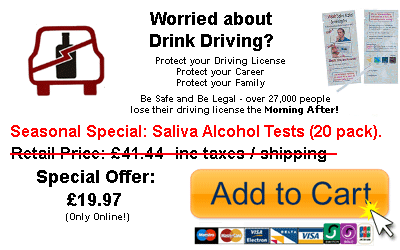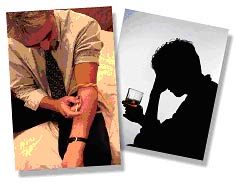
Alcohol Abuse Facts and StatisticsDetailed alcohol information and a supplier of alcohol test kits.
…from your Partners in Patient
Care.
|
||||||||||||||
|
|
Alcohol Abuse - The Facts!An alcohol fact sheet published by the Institute of Alcohol Studies (IAS) reports that in developed countries, alcohol is the third leading cause of disease and injury, alcohol causing nearly 10 percent of all ill health and premature deaths in Europe. This is ahead of obesity, diabetes and asthma and second only to smoking and blood pressure conditions. In addition to the large-scale problems of intoxication, addiction and a multitude of alcohol related social problems, alcohol on a worldwide level causes an estimated 20 – 30 percent of cancer of the oesophagus, liver cancer, cirrhosis of the liver, epilepsy, homicide / murder and motor vehicle accidents. In the 2002 World Health Report, the World Health Organisation estimated that globally 1.8 million people’s deaths every year are directly attributable to alcohol consumption. Moreover, it has been proven that a country’s drinking levels directly parallel the level of harm caused, ie the more a country drinks, the more alcohol-related harm occurs. The UK is one of the top ten in the world for alcohol consumption per head of population and alcohol abuse is clearly escalating. The Office for National Statistics reported in November 2006 that the alcohol related death rate in the UK doubled from 4,144 deaths in 1991 to 8,386 deaths in 2005. The death rate may be broken down by gender, with studies indicating that alcohol related death rates are much higher in males. The gap between female and male death rates is increasing and in 2005 the rate was more than twice that of females with males accounting for more than two thirds of the total alcohol related deaths. Those living in deprived areas have a much greater risk of an alcohol related death. Alcohol abuse, as a cause of death in the UK, has been estimated at 8000 – 40,000 annually, according to the IAS. The lower figure constitutes deaths caused by alcohol defined causes such as chronic liver disease. The upper figure is an estimate of all other deaths in which alcohol has contributed but is not alcohol defined, such as falls, suicide and motor vehicle accidents. Alcohol misuse within the UK is highest in Scotland. Whilst the population in England drink more frequently, the Scottish population are more likely to exceed recommended daily limits of alcohol with males consuming more than double female alcohol intake. A quarter of women and two in five men in Scotland exceed their daily limit. There were 41,651 alcohol related discharges from hospitals in Scotland alone in 2006/7 which is an increase from the previous year’s statistic of 39,061. According to the Chief Executive of the national charity Alcohol Focus Scotland, ‘the number of people in Scotland hospitalised through drink has soared by 270% in only 15 years.’
Additional Alcohol StatisticsHere are some examples of alcohol related harm in Scotland caused by factors other than an alcohol related disease as published by the Scottish Government:
The Home Office Minister Vernon Coaker estimates the overall economic damage as somewhat heavier – ‘alcohol abuse still costs us £20 billion a year in crime and damage to health.’ The UK is demonstrating its commitment to combating alcohol misuse and action taken so far includes the allocation of funds to alcohol treatment and rehabilitation centres, public information campaigns to raise alcohol awareness, a licensing act and implementation of local alcohol action plans with strategies for a long term proactive approach to dealing with nationwide alcohol abuse.
Please also see our Tackling Drug Addiction - for Parents and Families page. |
||||||||||||
|
||
|
|
© Drug-Aware Ltd 2002-2012. Unauthorised duplication or use of material from this web site is strictly prohibited. ALL RIGHTS RESERVED.
“Drug-Aware”, the Drug-Aware Logo and “Your Partners in Patient Care” are all Trade Marks of Drug-Aware Ltd.
Disclaimer - Whilst Drug-Aware Ltd has made every effort to ensure that all alcohol abuse facts and statistics information on this web site is current and accurate, we cannot be held responsible for any losses, damages, costs and other consequences resulting directly or indirectly from using this site and any information or material available from it. To the maximum extent permitted by law, Drug-Aware Ltd excludes all liability to any person arising directly or indirectly from using this site and any information or material available from it.
Thank you for visiting www.drug-aware.com - the source for all of your alcohol test kit requirements


